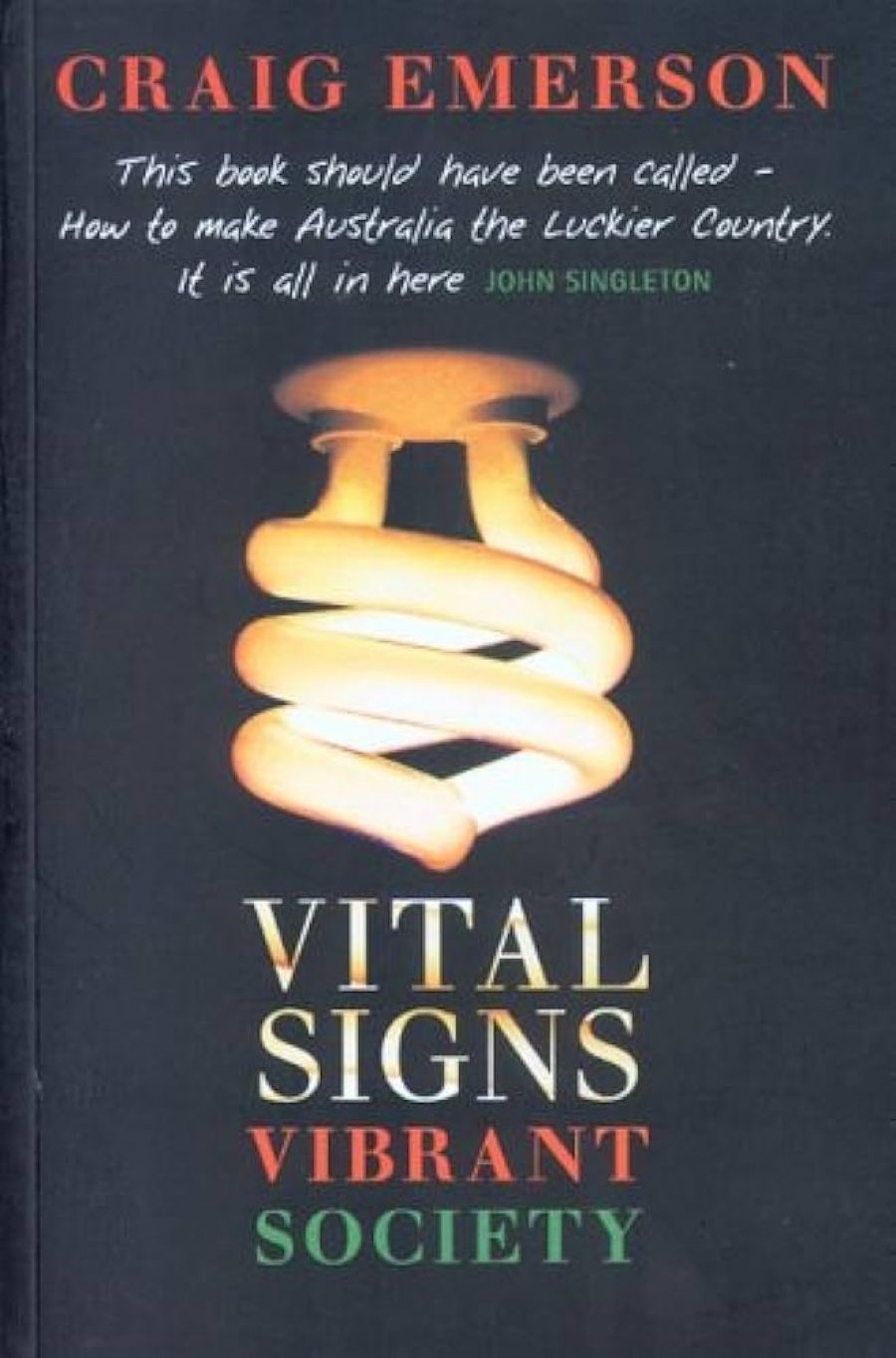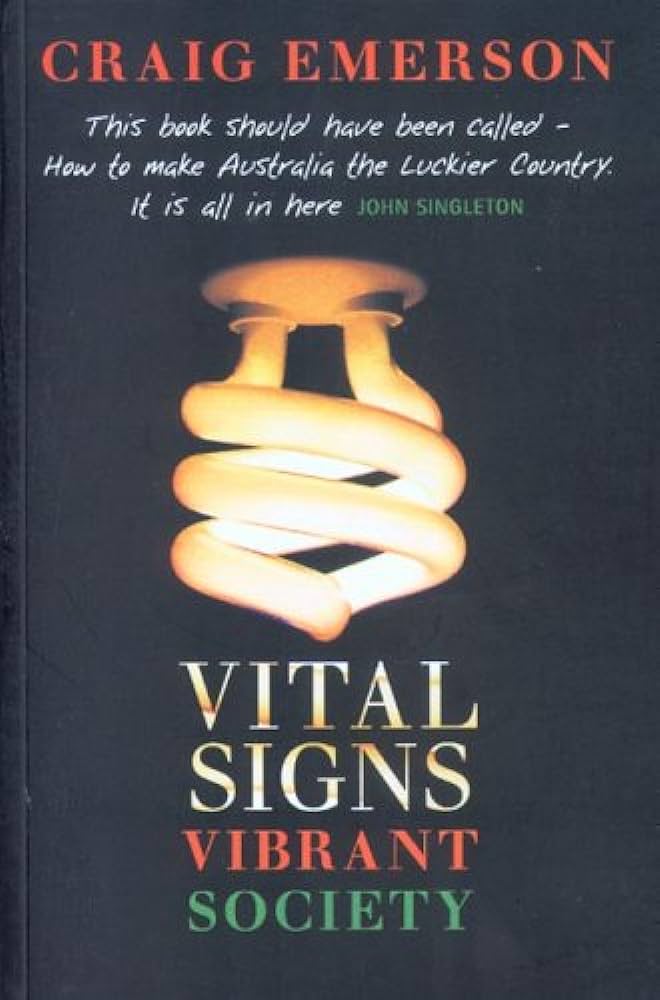
- Free Article: No
- Contents Category: Non-fiction
- Review Article: Yes
- Article Title: Beams of light
- Online Only: No
- Custom Highlight Text:
Craig Emerson is a good man to have around in federal politics. He has ideas, which is what politics should be largely about. And ideas, in the barnyard of Canberra politics, are almost as scarce as hen’s teeth. Emerson has a PhD in Economics from ANU. In earlier times, as an adviser to Prime Minister Bob Hawke, he had a reputation for being a bit of an environmentalist. Traditionally, the two disciplines don’t sit happily together. He managed to embrace them both.
- Book 1 Title: Vital Signs, Vibrant Society
- Book 1 Biblio: UNSW Press, $29.95 pb, 233 pp
- Book 1 Cover Small (400 x 600):

- Book 1 Cover (800 x 1200):

The message of Emerson’s book Vital Signs, Vibrant Society is pretty straightforward. Australia has been enjoying a period of unprecedented wealth, based on high productivity and high levels of international borrowings. The high productivity, generally attributed to the economic reforms of the 1980s and early 1990s, ‘has now gone into reverse after a record-breaking decade’. This alone suggests a likely decline in living standards. And there are other issues, of which a record international debt and a poor trade performance are frequently cited examples. There is a further looming and long-term problem: Australia has a significantly ageing population. This means a declining labour force and increased costs in areas such as health and aged care. These have to be paid for, together with other things such as education and infrastructure building, to improve our economic performance.
Emerson argues that Australia needs an economic plan, and sets out to provide one. It is a plan that would take some years to implement, encompassing as it does a big improvement in productivity, low inflationary growth and a reform agenda involving ‘hard decisions and making sacrifices along the way’. The ‘plan’ is outlined in the first chapter of the book and then elaborated in later chapters dealing with the main issues, such as health and aged care, education and training, ideas and innovation, regional policy, trade, and tax. Aspects of ‘the plan’ tend to complement each other: education is the key to productivity growth and competitive advantage. Regional development and immigration go hand-in-hand. He makes education a priority. The promotion of ideas and creative talent goes along with this, as does the rewarding of initiative through reforms to the taxation system.
At times there is too much detail in this book: tax, for example. Emerson’s suggestions about tax are thoughtful and impressive, but times change and the caravan moves on. Some of the more detailed aspects of the plan will arouse criticism and hopefully constructive debate. Professor Ross Garnaut has already indicated in a foreword to this book that he differs from the author in his assessment of the importance of a minimum wage. Others will doubt the capacity to double access to universities. But these are relatively small points in the scheme of things argued in this book.
Australia, Emerson argues, also needs ‘a nation building infrastructure plan that leads to more dispersed settlement patterns’, and it needs ‘a new wave of migrants to help build our nation again’. ‘Nation building’ has had a roller-coaster history in Australian politics; the idea generates both interest and enthusiasm. It flourished in Robert Menzies’ time, declined in favour under his immediate successors, enjoyed a brief revival with John Gorton and Gough Whitlam, and then slowly disappeared from the political lexicon, a victim of lazy politics and the tyranny of market economics.
Australia is a highly urbanised society. Cities such as Sydney are congested, without much room to grow. Regional centres provide a different and arguably better style of living and, in recent years, a level of heightened economic activity with the opening up of the economy. The author points to a bunch of regional centres ripe for growth. What they need is world-class infrastructure with modern transport, communications, and energy supply systems, supplemented by better medical services and education facilities. Migrants should provide the population increases.
What Emerson has done is to put together a vision for Australia based on economic principles applied with more creativity than Australians are used to in their politics. Visionaries are always at risk. The present government runs no such risks: as a number of commentators remarked at the time of John Howard’s tenth year in office, there is not much evidence that our prime minister thinks beyond the next election.
It is to be hoped that the ALP is influenced by some of Emerson’s thinking. It is imaginative and courageous on a number of fronts. He has, for example, not much time for ‘trade-diverting’ preferential trade deals such as the ALP has cravenly supported in recent years. When he discusses infrastructure policy, there is no hesitation in pointing out problems in Australia’s water usage patterns; that industries such as rice- and cotton-growing are prodigious users of water for their small benefit to the economy. ‘Political incorrectness’ like this is both brave and necessary.
Emerson is not a member of the opposition shadow cabinet. It is understood that he has offended Bill Ludwig, an apparatchik of the Australian Workers’ Union, by not always toeing the factional line. This view has been made clear in Canberra. Welcome to the contemporary ALP, where factional loyalty often carries more weight than political ideas.
Ultimately, if the ALP is to succeed, ideas will prevail. The book is a valuable contribution to the national eco-nomic agenda. It would be nice, of course, if someone else wrote a book of similar quality and passion about commitment to democratic processes, civil liberties, and the rule of law. Because, while ‘it’s the economy, stupid’ and this remains the biggest political issue, there are many other things that are important to voters and that will influence their confidence in future. Meantime, the author of Vital Signs, Vibrant Society has done his bit.


Comments powered by CComment